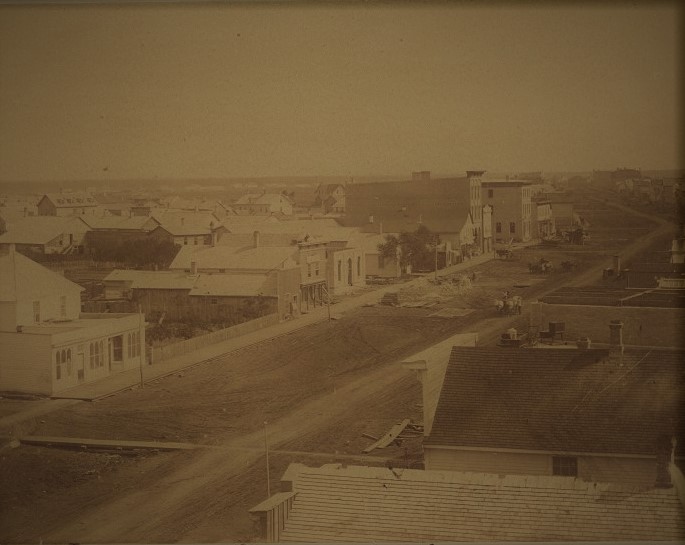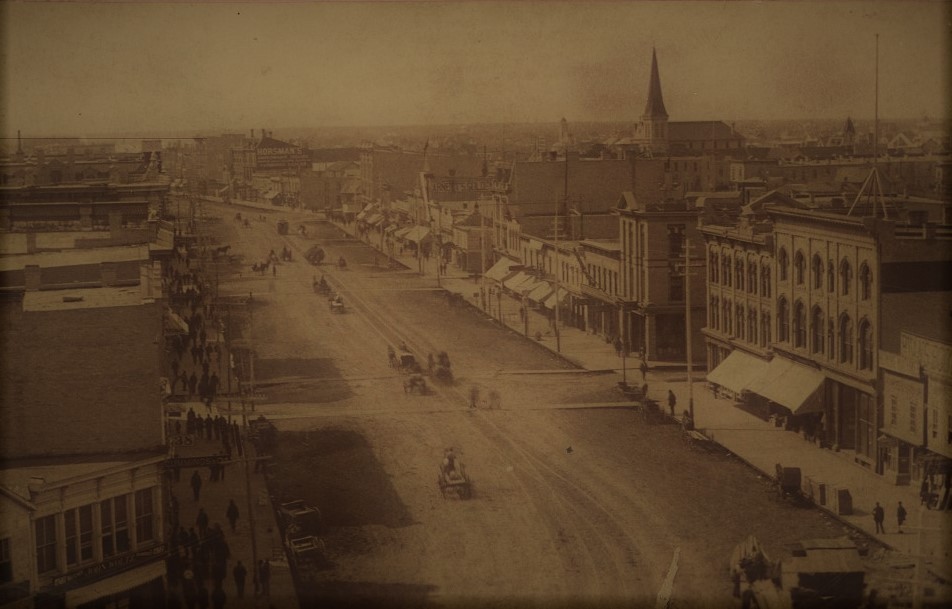
Winnipeg 1875 showing south Main Street.
Helgi Jónsson came west to Canada in 1875 and settled in Winnipeg. His story in the West is certainly different from other Westerners, because during the decade he lived in Canada, he tackled a variety of projects. The judgment of his western countrymen is unrelenting, and some of his fellow travelers tried various methods to slander and belittle him. It is no secret that he often acted with more zeal than prudence, taking on tasks that would have been better suited to others, e.g. I thought the paper Leifur was poorly written. He was considered a good carpenter and a hard worker, so it may well be that the hammer suited him better than the pen. He went big on investments, was always willing to take risks in matters that sometimes brought him great wealth but also plunged him into great debt. The opportunities were truly there in Manitoba during Helgi’s early years, namely 1876-1883. A steady stream of immigrants to Canada spread westward, the Canadian plains awaiting settlers from the borders of Ontario in the east to the Rocky Mountains in the west. At this time a railway was laid from Toronto to Winnipeg, which in a few years changed from a small village to a populous city. Helgi can be credited with the fact that he soon saw many opportunities during this prosperous period. While some of his peers worked as day laborers in street construction or railway construction, Helgi bought plots of land, built houses and sold them. Reverend Friðrik J. Bergmann wrote about Helga in Ólaf Þorgeirsson’s Almanak in Winnipeg in 1904. Let’s see what a cleric said about the entrepreneur:
“One of the most unusual Icelanders who is here in Winnipeg at the moment is a man who we have already mentioned in the story, Helgi Jónsson, and whose name was Hallgrímsson, a farmer at Sandfell in Skriðdal in Suðurmúlasýsla. He emigrated from Iceland to Canada in 1875 and came to Winnipeg early. He was a man rather solitary in his mood and somewhat secretive, but a good boy, energetic and efficient, so that he many times found the opportunities, which seemed impossible to others. As previously mentioned, (See Towns and Cities; Winnipeg) he bought a piece of land in Winnipeg before any other Icelander. The plot of land is a little west of Isabel Street and lays between Pacific and Alexander Aves. Helgi bought it in October 1880 and sold it again in June 1881. During that period, the price of the plot had almost increased sixfold. And the first Icelandic houses in the city must have been those built by Helgi and Baldvin Benediktsson, who is now a farmer in the Argyle district, in the spring of 1881. One of them was built for Eyjólf Eyjólfsson from Dagverðargerður in Hróarstunga in Norðurmúlasýsla, and the other for Guðrún Jónsdóttir Arason from Máná á Tjörnes in Þingeyjarsýsla. (insert: Eyjólfur came west with his family in 1876 and Guðrún, on the same ship and the same year with his parents Jón and Rebekka) At least one of these small houses is still standing; they were on the west side of Gertie street, between Bannatyne and McDermot Ave., a little south-west from the Victoria and Albert schools (the so-called Central school). Helgi Jónsson was very involved in the society of Icelanders. He thought that the Icelandic association (Íslendingafélagið) was not very organized and felt that it could do much more than it did. He encouraged the association to acquire houses, and when others saw no possibilities, he pretended to see countless. Finally, he bought a plot of land and gave it to the society. It seemed a magnificent gesture and construction had already begun. But in the fall, around Oct. 4, he embarked on a cruise to Iceland. He stayed there for the winter, but then returned back to the west. He then built a mansion on the southeast corner of Spence and Notre Dame streets. That property would have cost him about 4,000 dollars at least. At that time, he had a lot of money in real estate, but he also had a lot of debt, and now there was no real estate to sell, but he had to pay interest on debts and taxes and obligations that came with the real estate.”
English version by Thor group.

Winnipeg shortly after 1880. View south of Main St.
